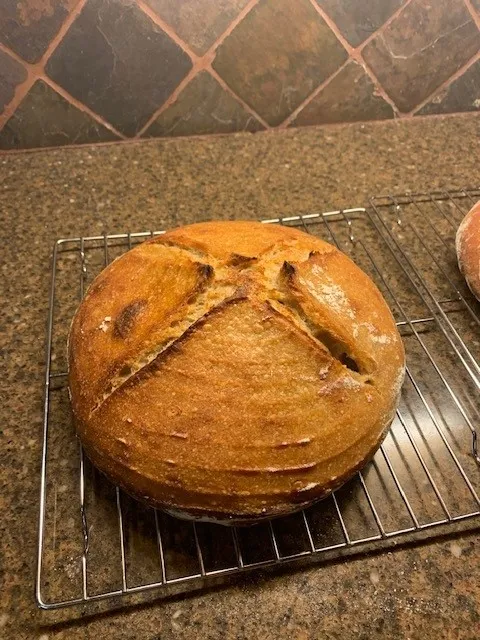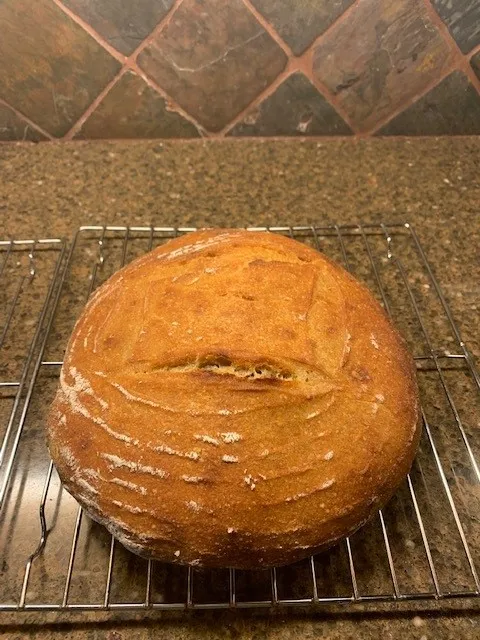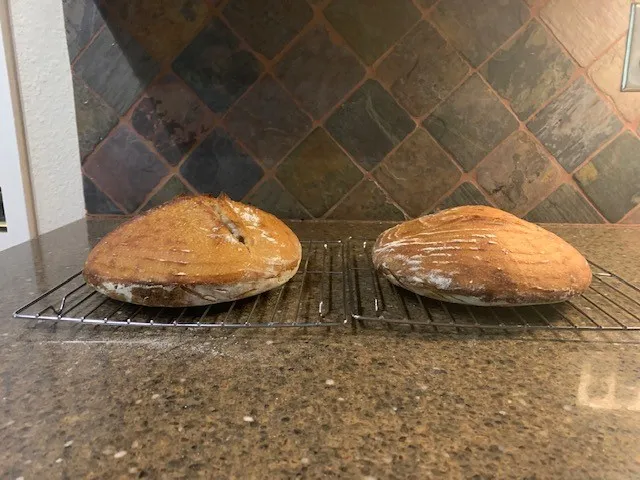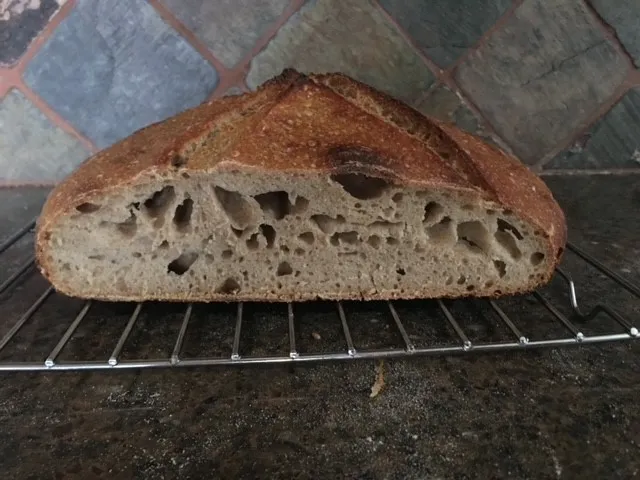
This novice would appreciate advice on some challenges I'm having baking with levain. Yesterday, I tried a version of Ken Forkish's FWSY Overnight Country Brown recipe, which I adapted due to concerns about overfermentation expressed in other posts. Essentially, I used his recipe but shortened the bulk fermentation and tried an overnight proof in the fridge. The results were better than my first try (which produced flat but tasty loaves), but only one of the loaves rose much in the oven, and the crumb with very large holes is a bit odd. 


The formula is 70% white flour (KA AP), 30% whole wheat flour (KA), 78% water, 2.2% salt, and 12% of the total flour is levain (that I prepared using Forkish's methods).
1. I began with autolyse for 30 min followed by mixing the dough with pincher method. Dough temp at this point was 75 degrees (a bit cool despite using warmer water than the recipe calls for).
2. I did four stretch and folds and then bulk fermented by putting the tub in the oven on the proof setting. Oven temp in this setting is about 75-80 degrees.
3. Following TFL guidance, I watched the dough carefully (including a 30 g aliquot in a small container), with the goal of stopping BF when the dough was approach twice its volume. The dough seemed to rise to about 125% after 2 hours but then seemed to stop. After close to 8 hours after mixing, the dough remained only perhaps 125% of its initial volume, and I decided to stop, as some posts had tables suggesting a fermentation a bit shorter than this for this formula.
4. I divided and shaped the dough, put in proofing baskets, and put into the fridge for 9-10 hours.
5. After proofing in the fridge, the dough had shrunk down and was a bit difficult to extract from the baskets. But I managed to pry the loaves out intact, score them, and baked them in two dutch ovens at 475.
As shown above, one loaf seemed to open up and rise, while the other didn't have much spring. Taste is delicious, but the crumb is somewhat odd with many large holes but areas with less aeration.
Am I completely off track with this approach? Could there something wrong with my levain, such that the dough doesn't rise during BF? Does the odd appearance of the crumb point to a specific technical problem my approach? Or is my "good" loaf what I should expect for levain boule with 30% whole wheat?
Yes, there is something wrong with your starter. But instead of trying to fix that, I suggest you pick some super basic plain white flour yeasted recipe at reasonable hydration (65-68%) and learn to bake that consistently. Biga, poolish, whatever. Just one. Over and over again. Plain white bread is actually great when done right.
Feel the dough, use the jar, whatever, but learn what what well-fermented dough feels like. Make it collapse. Learn the point at which to bake it to get the best results. Then start adding whole grain flours, increasing hydration and all that jazz. Right now you're dividing lifeless dough while cargo culting someone else's way of doing things. But the basics don't change no matter how you leaven your dough. It's all about managing fermentation, but right now you can't tell whether anything is happening at all.
Bet the crumb experts here would say it looks under fermented bah bah bah but how could a dough that rose 125% be under fermented, right? Did you use a sourdough starter for this dough? How old is your sourdough starter? I have a 3 month old SD starter that has been giving me inconsistent baking results, but I can't figure out what is wrong with it. You might want to try using instant yeast and just plain white flour to gain some experience as suggested by the other post here. Good luck!
Ming, If I parse his statement correctly, his dough increased by 25%. Ie, his delta was 25%.
"the dough remained only perhaps 125% of its initial volume"
"remained", not "increased by".
Of course, your interpretation would be correct if he used incorrect grammar. I, with my Asperger's, have to take him literally. (IE, he did not use 125% as a "delta" as we normally do here.)
Haha, my bad, thanks for the interpretation. Cheers!
It should not take 8 hours for your bulk fermentation. How old is your mother starter? It’s possible it is not lively enough. The dough does look under developed. How long does you starter take to double in size?
@Josh, Welcome to TFL!
Forkish is one of the generally-accepted "bread gods," and his book is popular around here. I have both a hard-copy and a Kindle edition.
My thoughts:
Over-fermented, not under. Evidence: Crumb has collapsed. Big bubbles are elongated in vertical direction. Scores didn't open much.
Over-hydated. Evidence: Crumb looks too wet. Dough stuck to banneton. Crust is too shiny/smooth. Since you're not using flour from the same sack Forkish did, expect to make hydration adjustments +/- from his.
Too much heat coming from above. Evidence: Top crust is darker than bottom crust, at least the cross-section of bottom crust that shows on the crumb photo. -- Use bottom heat only, if you can. Do not use top heat once lid comes off. If you have to use convection, lower temp by 20 to 25 F. -- "Top heat kills bread." (There are exceptions, of course. You have to learn how to handle it.) -- If you cannot turn off the top heating element, place DO one rack lower.
HTH.
I picked up on this:
"The dough seemed to rise to about 125% after 2 hours but then seemed to stop. After close to 8 hours after mixing, the dough remained only perhaps 125% of its initial volume,.."
A too acidic levain could also cause this observance, and also the "collapsed crumb" effect that I see.
Did you actually make a _levain_ "from" your starter (as Forkish says), or... did you directly use "starter" in your final dough? (Sorry, just now read that you did use his levain method.)
"and 12% of the total flour is levain (that I prepared using Forkish's methods)."
Whoops. From page 174, it says:
"The baker's percentage for levain is the amount of flour in the levain expressed as a percentage of the total flour in the recipe."
Did you mispeak, or do you think you misinterpreted what he meant?
If you can share your exact measurements, we can work backward to see.
"I did four stretch and folds and then bulk fermented by putting the tub in the oven on the proof setting. Oven temp in this setting is about 75-80 degrees. "
Yet...
Forkish's kitchen is 70 during day, and 65 at night. Several places in FWSY, pages 28 & 65 and more, he says his daytime room temp is 70 F. On page 66 he says his overnight house temp is 65 F / 18 C.
He's saying the bulk ferment is overnight, 12 - 15 hrs, hence at 65 F. And your temp, @'10 to 15 degrees higher, is going to favor some more LAB growth, and possibly make your levain and dough more acidic, contributing to the gluten breakdown of the crumb.
Hence, it's possible that your dough was both under-femented, but damaged by excess acid. Or, may have been both over-fermented and acid-damged.
It may depend on how you interpreted the 12% levain statement. Was your total levain (flour + water) equal to 12% of total recipe flour? Or was the "flour in the levain" equal to 12% of total recipe flour?
(Note to those who don't have the FWSY book: Forkish uses an 80% hydration levain in this formula.)
I greatly appreciate your insightful analysis! It's humbling to see how many little things I did may have contributed to the lackluster result. In answer to your questions:
1) I added the amount of levain Forkish recommends (so 12% of the total flour derived from levain).
2) My choices on the bulk ferment were driven by a poor prior rise with the overnight 12-15 hour room temperature ferment and my readings on TFL that shorter total bulk ferment would be appropriate for this formula. Doing the BF in the oven using the "proof" setting was a rookie impulse. (I was probably trying to split the difference by doing a shorter BF than Forkish recommends but at higher temperature, but this decision was not very well thought out.)
3) I prepared the levain also using the Forkish method -- essentially built from a mix of white and whole wheat flours over 5-day period with daily feedings. After my initial try at this recipe (which yielded flat but tasty loaves), I stored the levain in the fridge for about 1 week and then re-fed x 2 days as recommended by Forkish.
Your insights on top vs. bottom heat are very helpful. As it happens, I was using convection mode on my oven, so the heating element was indeed above the bread.
Of all the potential issues with your bread. What sticks out at me is that your starter is basically only 5 days old. I know Forkish says you can create a starter in 5 days but it really won’t be mature. It takes a lot longer than 5 days.
So take your starter out of the fridge and start feeding it twice a day at a 1:2:2 ratio or more for at least two weeks. Use small quantities (10 g?) so you aren’t wasting tons of flour. Then try baking with it.
At that point, you can give it a good feed 1:4:4 and put it in the fridge. It will be good for a week. Then use some to build a Levain for your bread, feed the rest and put back in the fridge. No counter time.
Don’t let it go more than a week without feeding it. Ask me, I screwed up my starter by 1, not stirring each week and 2, not feeding it each week. It took a while for it to mess up my loaves but when it did, it did a real number on them. Dough split at shaping and felt like goo. Don’t be like Danni. Take good care of your starter.
@Danni, good catch. I did not pick up on that in my reading of his comment until you pointed it out.
@Josh: That's the crux, then. It was underfermented due to an immature starter/levain, with possible damage from acid buildup from being put in the fridge for a week at such a young age. I concur with Danni's recommendation. It normally takes 10 to 21 days for a new "created from scratch" starter/levain to mature and balance out between yeast and LAB.
Starter creation and maintenance is one weakness of FWSY. He wastes a terrible amount of flour for his maintenance regimen. Most of us keep small amounts of "starter", and at the last feeding before a bake that is when we give it a big feed to create enough "levain" to put in the dough.
There is a lot of wiggle room in the definitions of "starter" and "levain". Generally speaking, the TFL tradition is to call "starter" what we keep and maintain on an ongoing basis. Then the "levain" is what we make _from_ the "starter" by taking either a portion of the starter, or all of the starter, and feeding it enough flour + water to create a fermented mass, and we then put this fermented mass, the "levain", in our dough.
Right now, I have three different "starters" in my fridge, about 45 grams each. When I feed one of them, I discard 30 grams (keeping 15 grams) then add 15 g water and 15 g flour. We call that a 1:1:1 feed. Starter : Water : Flour.
Doc dough made a great flow-chart which is at the top of this post:
https://www.thefreshloaf.com/node/68585/methods-and-rationale-sourdough-starter-maintenance-and-elaboration
The key levain paragraph for the Overnight Country Brown is step 1a on page 174. He is saying to use a 1:4:5 feed, (starter : water : flour) in amounts to end up with 216 g levain for the recipe, plus extra to "put back" or "carry on" as the ongoing starter. And to keep what you make at room temp (70 degrees) for 7 to 9 hours.
A good idea is to not completely use up your starter when making your levain, in case the feeding goes haywire and you ruin and lose your starter.
Say you have 50 g of starter. To make this levain, take starter out of fridge, remove 22 grams of starter and put that 22 grams in a new vessel, and put the old vessel containing the 28 grams back in the fridge.
To this 22 grams, add 4 times as much (85 to 90 degree) water, 88 grams, and 5 times as much flour, 110 grams. This makes a mass of 220 grams levain. It should be ready in 7 to 9 hours. Which should correspond to it at least doubling.
You can fiddle with the numbers if you want to make more than 220 grams so that you can use the leftover to completely replace that portion of "starter" (those 28 grams) that you left in the fridge. For instance, instead of taking 22 grams out of the 50, take 27 grams from the fridge (leaving 23) , feed it 1:4:5, which works out to 27:108:135. That gives you 270 grams of new levain. Use 216 g in the recipe, put 54 grams of this new levain in the fridge, and toss out the 23 grams still in the fridge. But... don't throw away that old 23 grams until this new batch proves itself, a screw up could ruin it (ie, sh!t happens.)
That is just one way to do it. There are many ways to maintain a starter and "make levain from your starter." Your starter feeding schedule does not always have to rely on baking bread. You can discard/feed even when not baking.
Who wants to waste 400 grams of flour for every batch of 2 loaves of bread you bake? That is one drawback to the FWSY method/system.
to your post above. I would feed the part that he is putting back in the fridge. It will have used up a lot of food during the levain making period. I’m not sure there would be enough left, even with stirring to keep that starter healthy in the fridge. It would probably survive but not be at its best.
I would suggest feeding it again a 1:5:5 or whatever ratio you want and popping it directly into the fridge. I didn’t explain above but if you let it rise on the counter, it uses up food that it will need to survive in the fridge. The warmer it is, the more food it goes through. Keeping it cool slows down the beasties and their appetite.
Doc Dough did some testing and this method seemed to come out on top. I’ve adopted it and my starter is so active now that I only do two builds to get my levain ready as before I used to do 3 or 4 builds.
That's good. Thanks.
But I get far better results by actually allowing my starter to at least double then refrigerating. I think building up acidity helps keep a healthy starter warding off other bacteria and mould. My starter is raring to go when building a levain. In fact Hamelman's starter schedule is leftover levain put into the fridge for next time.
I was not feeding or stirring my starter regularly and the whole thing went way too acidic. I know things have been so much better following Doc Dough’s recommendation from his experiments.
I only keep a few grams at any one time. When I bake it get's a healthy feed. My starter responds very well when the yeasts and bacteria are allowed to propagate to a healthy level before refrigeration. A long time ago I did the feeding and refrigerating straight away and it was more sluggish. Now it springs to life whenever it's fed.
I'd recommend Hamelman's Vermont Sourdough over Forkish for someone starting off with sourdough. Forkish tends to be a bit trickier with more hits and misses. It's too finicky when it comes to hydration and temperature. It seems he has formulated his sourdough best to work in the North Pole (a slight exaggeration) and if you use a flour any weaker than his it'll be far too hydration. Hamelman's Vermont seems to be a bit more of a sound recipe with excellent results. Hydration isn't too high and should suit a lot of bread flours. Plus, his levain technique with percentages leaves less room for unpredictable results.
Just bought the book - thanks for the suggestion.
Great recommendation from Abe. I first made Vermont sourdough over 15 years ago and still make it weekly as our everyday bread. In Hamelman's Bread editions 1 and 2, the hydration is 65%. In the latest edition 3, the hydration is 70%. I baked a couple of loaves with 70% but preferred the crumb of 65%. I hand mix my dough and make 2 x 750-gram loaves at a time. Hamelman's book is the best for technical information and I love it. Look out for his tips to get consistent results. I alternate between making the VSD with10% whole-rye or 10% whole-wheat. I use white flour at about 11.5% protein and it gives a great result. I bake this bread on stone with steam.
Cheers,
Gavin.
Josh, Let us know if you want further kibbitzing/advice/pontificating/clarification in regards to working your way through Forkish, or whether you want to put FWSY on the back-burner and just switch to Hamelman.
I hope I didn't over-whelm you or run you off.
Based on all of the excellent advice I received, I made several changes on my next bake:
1) I paid attention to my levain culture (feeding twice a day for a few days as suggested by Hamelman), because some thought my culture might have been weak.
2) I used a dough recipe with less whole wheat flour to build my beginner's skills. (This is Forkish's Pan de Compagne with 10% whole wheat.)
3) I reduced the total water content a bit (from Forkish's 78% to 76%) because some thought my dough was too wet.
4) I watched my dough carefully during BF to avoid overfermentation.
...and the results were fantastic!
I felt joy when I opened the dutch ovens to see the glorious oven rise! I've never achieved that in any prior bake. There is no cooking experience that has given me this much gratification. I suppose this is what motivates so many bakers to keep baking?
(I will avoid the burnt tops by removing them a few minutes earlier next time.)
Excellent oven spring and such a lovely caramelized crust.
Perfect!
Such a marked improvement! Well done. I can identify with the gratification one gets to seen a well baked bread coming out the the oven. Incidentally, some people prefer a bolder bake like this one, if you don't like the crust taste do what you plan for next bake.
Cheers,
Gavin
PS I've just found some notes I made years ago when first making Hamelman's VSD:
How to get repeated success with Hamelman's Vermont Sourdough.
· Always have an active starter to build the final levain and mix the dough at its peak.
· Use baker's percentage and scale all ingredients.
· Take the time to measure the temperature of the room, flour and levain and work out the desired water temperature so you can achieve a final dough temperature after mixing of 24 to 25C.
· Use a proofing box set at 24 to 25C to maintain dough temperature. This will give you the predictability of your schedule.
· Mix to incorporate ingredients leaving out the salt. Autolyse 30-60 minutes.
· Mix to moderate gluten development.
· Perform stretch and folds during bulk fermentation. (I do two at 50-minute intervals and shape after a further 50 minutes). This will develop and strengthen the gluten framework.
· Final ferment (proof) for 2 to 2 1/2 hours; (or retard in the fridge until the next day works great for additional flavour, but not essential).
· Presteam the oven and bake in a hot oven 238C for 40 to 45 minutes. Maintain steam for about 10 minutes after loading the loaves. Lower to 215C after fifteen minutes and finish in a drying oven.
· Allow cooling before cutting.
Super nice loaves!
Great bake. It’s always great to see that nice open and creamy crumb when cutting into a loaf like this one.
Well done, great baking improvements you’ve made! I like the dark bake, dark bake = more flavour.
Benny